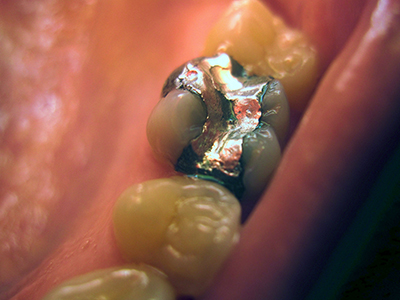 There has been some controversy over a kind of dental filling. Some claim that it is toxic because it contains mercury. These dental fillings are dental amalgam, which is 50% mercury.
There has been some controversy over a kind of dental filling. Some claim that it is toxic because it contains mercury. These dental fillings are dental amalgam, which is 50% mercury.
Take a look at your mouth in the mirror. Do you see any gray or silver fillings in your back teeth? Those are most likely to be dental amalgam. You’re probably thinking, “Mercury! Isn’t that the toxic heavy metal that pollutes the environment and makes us cautious about certain kinds of seafood?” If you’re starting to panic…don’t!
This article will hopefully answer the following questions:
- Are dental amalgams safe?
- What should you do if you have dental amalgams?
- What should you consider when getting any future tooth fillings?
Before we dive into those questions, let’s explore a little history.
Dental amalgam fillings are not a new innovation in dentistry. They might have been first used by the Chinese as early as 659 AD. In Europe, they were likely used by the 16th century. Modern dentists have been using it for more than 150 years.
Throughout history, there have been “amalgam wars” and ongoing controversy over the use of mercury, but these it has consistently been used. Its reliability in load bearing situations and low cost is unmatched by other forms of dental restorative material. It is the no.1 choice for patching the back teeth.
Are dental amalgams safe?
In recent years, there has been research suggesting that mercury vapor is released from silver fillings. However, do they pose an actual health risk? Does enough mercury escape from amalgam restorations to cause adverse health effects? Up till now, there is insufficient evidence to label amalgam as hazardous to the human body and halt its use.
Here are three facts to support the use of amalgam:
- After the dentist places the filling and the reaction is complete, only a tiny amount of mercury is released, which is far below the current health standards.
- Mercury does not collect in human tissues. It takes an average of 55 days for mercury to move through the body to the point of excretion.
- Mercury acts as a bacteriostatic agent. Since there are many bacteria in the oral cavity, this is a desirable characteristic as it stops current decay and prevents future decay.
Reputable regulatory bodies such as the U.S. Food and Drug Administration (FDA), American dental Association (ADA) and Malaysian Dental Council (MDC) also back the use of dental amalgams.
ADA: “The scientific evidence supports the position that amalgam is a valuable, viable and safe choice for dental patients.”
FDA: “While elemental mercury has been associated with adverse health effects at high exposures, the levels released by dental amalgam fillings are not high enough to cause harm in patients.”
MDC: “The Malaysian Dental Council (MDC) continues to support dental amalgam as a restorative material especially in load-bearing areas of the mouth such as for posterior permanent teeth.”
What should you do if you have dental amalgams?
Some people in the “holistic dentistry” circle have successfully convinced a number of individuals with perfectly good amalgam fillings to have them removed and replaced with composites. There is actually no need to remove those fillings as the process of removal may release more mercury vapour.
Removal is not recommended unless there is a true hypersensitivity to mercury. Mercury allergy is rare but may cause skin rash or dermatitis. This affects a tiny subset of the population. So don’t rush to remove any existing amalgam fillings unless you are confirmed to be allergic to mercury.
What should you consider when getting any future tooth fillings?
We live in an age of choices, therefore it’s best to start with knowing what kind of options we have. Although amalgam is hardly harmful, there are benefits of using other materials. These days, the focus if on aesthetic dentistry and the use of tooth-coloured fillings is on the rise. In fact, it is the benchmark for most developed countries. If your dentist can offer an excellent quality tooth-colored filling to ensure long-term sustainability, go for it. If not, there is good old-fashioned amalgam.
With many improvements in other dental materials like composites, they are a viable option to be considered especially if fillings can be seen when you smile or talk. They are great aesthetically – matching and mimicking teeth shade to the extent that it cannot be identified as restoration.
There will always be people with opposing views when it comes to dental fillings. Those against amalgam are usually “naturalist” and “holistic”. However, the scientific community as a whole still believes in the use of silver fillings.
Fact is, large amalgam fillings will probably last for more than 20 years and cost less than ½ of a crown. They may not look pretty, but patients can chew with confidence. The peace of mind of having a restored tooth to safely eat your favourite food is priceless!
In the end, though some people have the misconception that dental amalgam is toxic, evidence has shown otherwise. They are safe and practical. That’s how we know it will stand the test of time for many, many years to come.
Dr. Edward Tay is a dentist with interest in preventive dentistry and empowering others in oral self-care.
References:
- https://en.wikipedia.org/wiki/Dental_amalgam_controversy#Organizational_statements
- http://mdc.moh.gov.my/uploads/dentalamalgam.pdf
- http://www.fda.gov/NewsEvents/Newsroom/Pressannouncements/ucm173992.htm
- http://www.ada.org/en/about-the-ada/ada-positions-policies-and-statements/statement-on-dental-amalgam
[This article belongs to The Malaysian Medical Gazette. Any republication (online or offline) without written permission from The Malaysian Medical Gazette is prohibited.]
